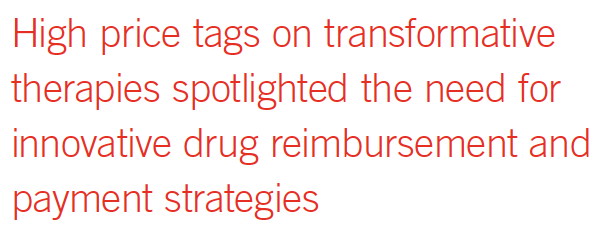Year in Review: R&D, Regulatory, and Reimbursement Hurdles
Pharmaceutical Executive
Sponsors developed important new therapies amidst ongoing concerns over drug quality and costs.
Notable advances in biopharmaceutical R&D and in bringing important life-saving medicines to patients were overshadowed in recent months by continuing public outrage over limited consumer access to costly new therapies, the devastation wrought by the opioid epidemic, and difficulties linked to drug shortages and quality issues. FDA also became embroiled in a rising number of deaths linked to vaping of e-cigarettes and disputes
Jill Wechsler

over regulation of cannabidiol products and oversight of e-health technology.
As industry and regulators worked to address these and other public health crises, analysts questioned whether the long-time R&D investment model that has supported the development of cutting-edge biopharmaceuticals in the US will be sustainable in the future.
On the plus side, pharma companies developed, and FDA approved, multiple new drugs and biotech therapies this past year, as new discoveries in genomics, cellular therapy, and data management continued to bear fruit.
Even if 2019 approval numbers don’t set new records, the list is notable, including Novartis’ controversial gene therapy Zolgensma, Vertex’s triple combo for cystic fibrosis, multiple breakthroughs in cancer therapy, and improved treatments for migraine, light-sensitivity, Parkinson’s disease, pneumonia, rheumatoid arthritis, tuberculosis, and urinary tract infections, to name a few.
The steady rise in applications for investigational therapies, however, has made it difficult for the under-staffed Center for Biologics Evaluation and Research (CBER) to keep pace, while the Center for Drug Evaluation and Research (CDER) continued to reorganize its Office of New Drugs (OND) to better assess and process the growing volume of submissions requiring special attention.
FDA and sponsors considered ways to more fully utilize real-world evidence (RWE) and real-world data (RWD) in identifying patients for clinical research and for tracking postapproval effectiveness and safety. This generated more interest in accessing data from electronic health records and from widening use of wearables that track patient responses in real time.
The importance of soliciting patient perspectives in designing more streamlined and informative clinical trials continued as an important theme, particularly for discovering new treatments for rare conditions and for testing breakthrough therapies. Related efforts aimed to better target potential products to patients likely to benefit from assessment of underlying genetic or molecular links to disease. Such advances put pressure on FDA to clarify a framework for regulating the burgeoning field of regenerative medicine that promises to develop new cell and gene therapies able to repair or replace damaged or malfunctioning tissues, cells and organs, as hundreds of unregulated, independent clinics continued to promote unapproved stem cell treatments.
Costs and value
At the same time, high price tags on transformative therapies spotlighted the need for innovative drug reimbursement and payment strategies. Health plans, payers, and policymakers continued to debate multiple proposals for reforming drug coverage and pricing, ranging from wider importing of less costly products from abroad, federal government price negotiations, and specific limits on annual price increases and patient out-of-pocket costs. There was much talk of “value-based pricing,” but diminishing attention to more radical changes involving drug rebates and foreign reference pricing.
And while low-priced generic drugs remained key to improving consumer access to many widely used medicines, industry has been plagued by manufacturing and quality control difficulties. The result continued to

be shortages in many critical medicines, particularly sterile injectables that are more difficult to produce reliably to meet FDA standards. A recent FDA report blamed too-low prices for many serious generic drug shortages, as limited profitability prompted manufacturers to discontinue production of needed products and other firms seldom moved to fill the demand.
At the same time, price hikes on some generics prompted lawsuits accusing firms of price gouging, while the rise in imports of finished drugs and pharmaceutical ingredients raised questions about product quality and supply chain security.
FDA’s capacity for dealing effectively with a mounting array of critical regulatory and policy issues were compromised last year by the unexpected departure of Commissioner Scott Gottlieb. Although the agency was led capably for much of the year by acting Commissioner Ned Sharpless, on loan from directing the National Cancer Institute, unconfirmed agency leaders have less stature in dealing with policy issues and budget debates and in keeping out of the fray over healthcare costs and coverage at the White House and on Capitol Hill.
An acting or new commissioner (Dr. Stephen Hahn was formally nominated for the post last month and grilled by the Senate) will face all these challenges, including pressure to clarify FDA’s role in speeding alternative therapies to market, in permitting the import of less costly drugs from abroad, and in requiring disclosure of drug prices or value information in advertising and labels.
Jill Wechsler is Pharmaceutical Executive’s Washington Correspondent. She can be reached at jillwechsler7@gmail.com

Navigating Distrust: Pharma in the Age of Social Media
February 18th 2025Ian Baer, Founder and CEO of Sooth, discusses how the growing distrust in social media will impact industry marketing strategies and the relationships between pharmaceutical companies and the patients they aim to serve. He also explains dark social, how to combat misinformation, closing the trust gap, and more.
Pfizer, GSK Gain ACIP Recommendations for RSV and Meningococcal Vaccines
April 18th 2025The Centers for Disease Control and Prevention’s Advisory Committee on Immunization Practices voted to expand access to Pfizer’s respiratory syncytial virus vaccine Abrysvo for high-risk adults in their 50s and voted in favor of GSK’s meningococcal vaccine, Penmenvy, for streamlined adolescent protection.